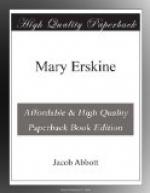Mary Erskine said that she thought it would be best for her to sell the stock and farming tools, because she could not take care of them nor use them, and she might put the money out at interest. The appraisers said they thought so too.
In the end, Mary Erskine was appointed guardian. The idea appeared strange to her at first of being appointed guardian to her own children, as it seemed to her that a mother naturally and necessarily held that relation to her offspring. But the meaning of the law, in making a mother the guardian of her children by appointment in such a case as this, is simply to authorize her to take care of property left to them, or descending to them. It is obvious that cases must frequently occur in which a mother, though the natural guardian of her children so far as the personal care of them is concerned, would not be properly qualified to take charge of any considerable amount of property coming to them. When the mother is qualified to take this charge, she can be duly authorized to do it; and this is the appointment to the guardianship—meaning the guardianship of the property to which the appointment refers.
Mary Erskine was accordingly appointed guardian of the children, and she obtained leave to sell the farm. She decided that it would be best to sell it as she thought, after making diligent enquiry, that she could not depend on receiving any considerable annual rent for it, if she were to attempt to let it. She accordingly sold the farm, with the new house, and all the stock,—excepting that she reserved from the farm ten acres of land around her own house, and one cow, one horse, two pigs, and all the poultry. She also reserved all the household furniture. These things she took as a part of her portion. The purchase money for all the rest amounted to nine hundred and fifty dollars. This sum was considerably more than Mary Erskine had expected to receive.
The question now was what should be done with this money. There are various modes which are adopted for investing such sums so as to get an annual income from them. The money may be lent to some person who will take it and pay interest for it. A house may be bought and let to some one who wishes to hire it; or shares in a rail-road, or a bank, or a bridge, may be taken. Such kinds of property as those are managed by directors, who take care of all the profits that are made, and twice a year divide the money among the persons that own the shares.
Mary Erskine had a great deal of time for enquiry and reflection in respect to the proper mode of investing her money, for the man who purchased the farm and the stock was not to pay the money immediately. The price agreed upon for the farm, including of course the new house, was five hundred dollars. The stock, farming utensils, &c, which he took with it, came to three hundred and sixty dollars. The purchaser was to pay, of this money, four hundred dollars in three months, and the balance in six months. Mary Erskine, therefore, had to make provision for investing the four hundred dollars first.




